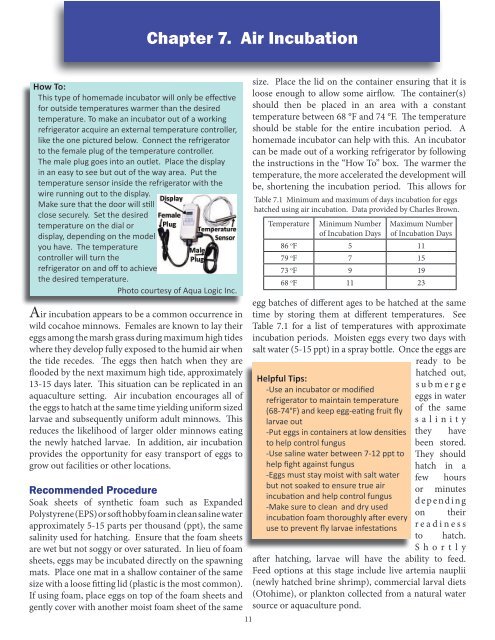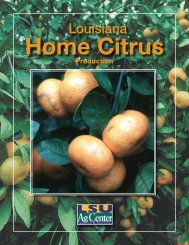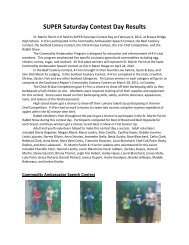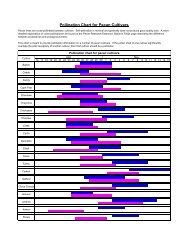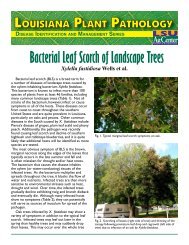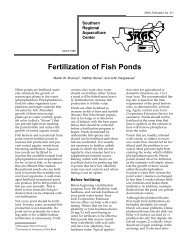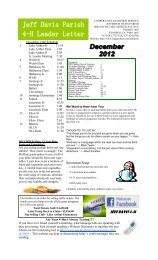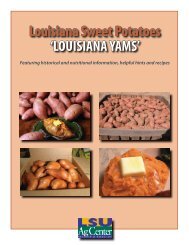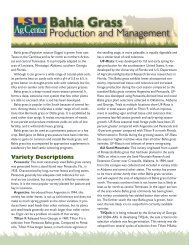Cocahoe Minnow - The LSU AgCenter
Cocahoe Minnow - The LSU AgCenter
Cocahoe Minnow - The LSU AgCenter
Create successful ePaper yourself
Turn your PDF publications into a flip-book with our unique Google optimized e-Paper software.
How To:<br />
This type of homemade incubator will only be effective<br />
for outside temperatures warmer than the desired<br />
temperature. To make an incubator out of a working<br />
refrigerator acquire an external temperature controller,<br />
like the one pictured below. Connect the refrigerator<br />
to the female plug of the temperature controller.<br />
<strong>The</strong> male plug goes into an outlet. Place the display<br />
in an easy to see but out of the way area. Put the<br />
temperature sensor inside the refrigerator with the<br />
wire running out to the display.<br />
Make sure that the door will still<br />
close securely. Set the desired<br />
temperature on the dial or<br />
display, depending on the model<br />
you have. <strong>The</strong> temperature<br />
controller will turn the<br />
refrigerator on and off to achieve<br />
the desired temperature.<br />
Photo courtesy of Aqua Logic Inc.<br />
Air incubation appears to be a common occurrence in<br />
wild cocahoe minnows. Females are known to lay their<br />
eggs among the marsh grass during maximum high tides<br />
where they develop fully exposed to the humid air when<br />
the tide recedes. <strong>The</strong> eggs then hatch when they are<br />
flooded by the next maximum high tide, approximately<br />
13-15 days later. This situation can be replicated in an<br />
aquaculture setting. Air incubation encourages all of<br />
the eggs to hatch at the same time yielding uniform sized<br />
larvae and subsequently uniform adult minnows. This<br />
reduces the likelihood of larger older minnows eating<br />
the newly hatched larvae. In addition, air incubation<br />
provides the opportunity for easy transport of eggs to<br />
grow out facilities or other locations.<br />
Recommended Procedure<br />
Soak sheets of synthetic foam such as Expanded<br />
Polystyrene (EPS) or soft hobby foam in clean saline water<br />
approximately 5-15 parts per thousand (ppt), the same<br />
salinity used for hatching. Ensure that the foam sheets<br />
are wet but not soggy or over saturated. In lieu of foam<br />
sheets, eggs may be incubated directly on the spawning<br />
mats. Place one mat in a shallow container of the same<br />
size with a loose fitting lid (plastic is the most common).<br />
If using foam, place eggs on top of the foam sheets and<br />
Chapter 7. Air Incubation<br />
size. Place the lid on the container ensuring that it is<br />
loose enough to allow some airflow. <strong>The</strong> container(s)<br />
should then be placed in an area with a constant<br />
temperature between 68 °F and 74 °F. <strong>The</strong> temperature<br />
should be stable for the entire incubation period. A<br />
homemade incubator can help with this. An incubator<br />
can be made out of a working refrigerator by following<br />
the instructions in the “How To” box. <strong>The</strong> warmer the<br />
temperature, the more accelerated the development will<br />
be, shortening the incubation period. This allows for<br />
Table 7.1 Minimum and maximum of days incubation for eggs<br />
hatched using air incubation. Data provided by Charles Brown.<br />
Temperature Minimum Number<br />
of Incubation Days<br />
egg batches of different ages to be hatched at the same<br />
time by storing them at different temperatures. See<br />
Table 7.1 for a list of temperatures with approximate<br />
incubation periods. Moisten eggs every two days with<br />
salt water (5-15 ppt) in a spray bottle. Once the eggs are<br />
ready to be<br />
Helpful Tips:<br />
-Use an incubator or modified<br />
refrigerator to maintain temperature<br />
(68-74°F) and keep egg-eating fruit fly<br />
larvae out<br />
-Put eggs in containers at low densities<br />
to help control fungus<br />
-Use saline water between 7-12 ppt to<br />
help fight against fungus<br />
-Eggs must stay moist with salt water<br />
but not soaked to ensure true air<br />
incubation and help control fungus<br />
-Make sure to clean and dry used<br />
incubation foam thoroughly after every<br />
use to prevent fly larvae infestations<br />
Maximum Number<br />
of Incubation Days<br />
86 o F 5 11<br />
79 o F 7 15<br />
73 o F 9 19<br />
68 o F 11 23<br />
hatched out,<br />
submerge<br />
eggs in water<br />
of the same<br />
salinity<br />
they have<br />
been stored.<br />
<strong>The</strong>y should<br />
hatch in a<br />
few hours<br />
or minutes<br />
depending<br />
on their<br />
readiness<br />
to hatch.<br />
S h o r t l y<br />
after hatching, larvae will have the ability to feed.<br />
Feed options at this stage include live artemia nauplii<br />
(newly hatched brine shrimp), commercial larval diets<br />
(Otohime), or plankton collected from a natural water<br />
gently cover with another moist foam sheet of the same source or aquaculture pond.<br />
11


